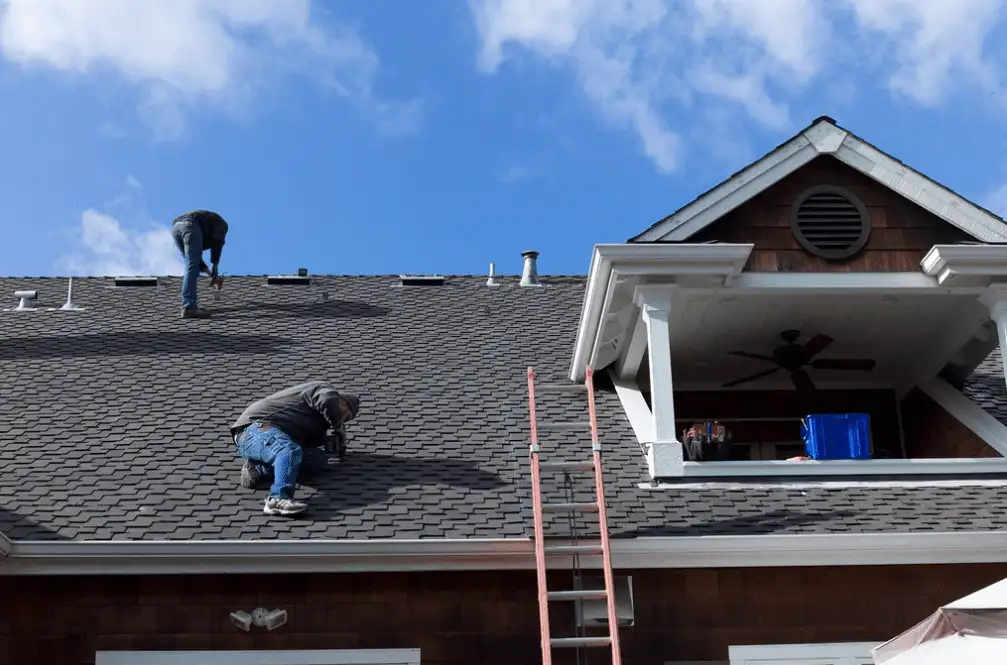Summer can bring more than just beach trips and barbecues. It can also bring significant strain to your roof from heat and the sun’s powerful UV rays, making summer roof maintenance crucial for every homeowner! This article offers a brief overview of essential summer roof maintenance tips, specifically tailored for Maryland homeowners in our region.
Why is Summer a Good Time of Year for Roof Maintenance?
In Maryland, the summer months can bring not just heat and UV radiation, but also violent storms and heavy rainfall. High humidity can encourage moss and algae growth, so regular roof cleaning is crucial. These extreme weather conditions can further exacerbate roof damage, emphasizing the need for extra care and preventative measures before the season rolls around.
Thankfully, the longer summer days allow for a roofing project to be completed in one day since there is more sunlight! Plus, climbing on a roof is safer when you don’t have to worry about ice and cold temperatures.
Extra Care Can Prolong Your Roof's Lifespan
Neglecting your roof can lead to expensive repairs and a shortened lifespan of your roofing system. By fixing minor issues promptly, you can prevent major damages that could lead to costly repairs or even a full roof replacement! By following these tips and engaging professional services from contractors like RoofPRO, you can enjoy a worry-free summer, knowing your roof is well-maintained and prepared to withstand whatever the season brings.

Six Crucial Summer Maintenance Tips for Maryland Roofs
Check out our tried-and-true summer maintenance tips for homeowners below! Contact RoofPRO today for more information and to schedule a free estimate.
1) Regularly Clean Your Roofing System and Gutters
Regular cleaning is a simple yet effective way to extend the life of your roof. Using the summer to clear loose debris from your roof and gutters is crucial because clogged gutters can cause water to back up into places and cause leaks. It’s also an ideal time to check behind any roof penetration, like a skylight, chimney, vents, and pipes on your roof, to ensure that they are in working condition.
Even if you have gutter covers, you might still need to clear debris from on top of the gutter covers, and it’s still advised that you check inside the covers to make sure they actually are working!
Debris in Gutters Can Cause Improper Drainage
Be sure to clean out not only the gutters but also the downspouts using a drainage snake. A clogged downspout or gutter can cause water to back up and rot the wood of your home’s eaves and fascia.
2) Replace or Repair Broken Shingles
Shingles serve as the first line of defense against harsh weather. Regularly inspect your roof for broken, loose, or missing shingles, especially after a summer storm. The easiest time to replace damaged shingles is in the warm summer season. If your roof is older, the shingles around the damaged portion will be brittle, so the heat will help soften them up for repair.
Every shingle around the broken area will need to be loosened up and disconnected in order to remove the damaged shingles. It is highly recommended that you contact a professional roofing company for any shingle repairs!
3) Check Your Attic for Signs of Leaks
Water stains, mold, and damp insulation in your attic are all signs of roof leaks. Prompt identification and repair can save your home from severe water damage! Whenever you’re in your attic you can look for signs of leaking that will appear as either water stains on the bottom of the roof deck or you might even see the insulation indented from the water dripping down.
This is also a good time to check your attic ventilation, because when it’s warm outside, you can instantly tell if there is airflow or if the heat is just building up. The ventilation of your attic is important because it directly affects the longevity of the roofing material and the temperature in the home.

4) Trim Large Tree Branches to Avoid Storm Debris
A little bit of preventative maintenance can save you significant time and money when it comes to protecting your roof. If you have tree branches that are close to your roof, it’s very important to have them trimmed back away from the house. When the wind blows, they can swing across the roof, scraping the roofing material and damaging it. Falling branches can also cause significant roof damage – trim overhanging branches to minimize the risk of storm debris.
5) Ensure Flashing is Working Correctly
Be sure to take a close look at your home’s flashing to ensure that your roof is still in good shape. The flashing is the material that covers the transition between the roof and a wall or penetration like a skylight. Flashing helps to direct water away from critical areas of your roof. Regularly check for loose or corroded flashing to prevent water leaks; you’ll want to look for either signs of rust, pieces that have slipped out of place, or exposed fasteners.
6) Schedule an Annual Professional Roof Inspection
Even with regular self-inspection and maintenance, it’s a good idea to have a professional inspect your roof annually. They can spot issues you may overlook and offer advice on proper maintenance to keep your roof in good condition. RoofPRO is proud to offer a wide range of services, from routine roof inspections and spot repairs to full roof replacements. As a top-rated roofer for Maryland homeowners, you can trust RoofPRO to deliver quality and reliable service!
Contact RoofPRO today to schedule an inspection this summer.


